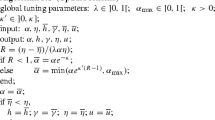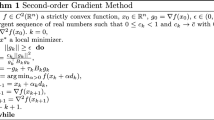Abstract
In this note, we describe a finitely convergent steepest-ascent scheme for maximizing piecewise-linear concave functions. Given any point, the algorithm moves along the direction of steepest ascent, that is, along the shortest subgradient, until a new ridge is reached. The overall process is then repeated by moving along the new steepest-ascent direction.
Similar content being viewed by others
References
Demyanov, V. F.,Algorithms for Some Minimax Problems, Journal of Computer and Systems Sciences, Vol. 2, pp. 342–380, 1968.
Bazaraa, M. S., andGoode, J. J.,A Survey of Various Tactics for Generating Lagrangian Multipliers in the Context of Lagrangian Duality, Georgia Institute of Technology, School of Industrial and Systems Engineering, Working Paper, 1974.
Fisher, M. L., Northup, W. D., andShapiro, J. F.,Using Duality to Solve Discrete Optimization Problems: Theory and Computational Experience, Mathematical Programming Study, Vol. 3, pp. 56–94, 1975.
Lasdon, L. S.,Optimization Theory for Large Systems, The MacMillan Company, New York, New York, 1970.
Geoffrion, A. M.,Elements of Large Scale Mathematical Programming, Parts I and II, Management Science, Vol. 16, pp. 652–691, 1970.
Wolfe, P.,Algorithm for a Least Distance Programming Problem, Mathematical Programming Study, Vol. 3, pp. 145–173, 1975.
Grinold, R. C.,Steepest Ascent for Large Scale Linear Programs, SIAM Review, Vol. 14, pp. 447–464, 1972.
Dantzig, G. B., andWolfe, P.,The Decomposition Algorithm for Linear Programming, Econometrica, Vol. 29, pp. 767–778, 1961.
Brooks, R., andGeoffrion, A. M.,Finding Everett's Lagrange Multipliers by Linear Programming, Operations Research, Vol. 14, pp. 1149–1153, 1966.
Held, M., Wolfe, P., andGrowder, H. D.,Validation of Subgradient Optimization, Mathematical Programming, Vol. 6, pp. 62–88, 1974.
Eaves, C. B.,Solving Piecewise Linear Convex Equations, Mathematical Programming Study, Vol. 1, pp. 96–119, 1974.
Eaves, C. B., andScarf, H.,The Solution of Systems of Piecewise Linear Equations, Mathematics of Operations Research, Vol. 1, pp. 1–31, 1976.
Tucker, A. W.,Least-Distance Programming, Proceedings of the Princeton Symposium on Mathematical Programming, Edited by H. W. Kuhn, Princeton University Press, Princeton, New Jersey, 1971.
Bazaraa, M. S., Goode, J. J., andRardin, R. L.,An Algorithm for Finding the Shortest Element of a Polyhedral Set with Applications to Lagrangian Duality, Journal of Mathematical Analysis and Applications (to appear).
Luenberger, D. G.,Optimization by Vector Space Methods, The MacMillan Company, New York, New York, 1969.
Author information
Authors and Affiliations
Additional information
Communicated by M. Avriel
Rights and permissions
About this article
Cite this article
Bazaraa, M.S., Goode, J.J. & Rardin, R.L. A finite steepest-ascent algorithm for maximizing piecewise-linear concave functions. J Optim Theory Appl 25, 437–442 (1978). https://doi.org/10.1007/BF00932904
Issue Date:
DOI: https://doi.org/10.1007/BF00932904




